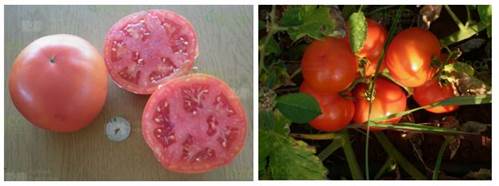Mi SciELO
Servicios Personalizados
Articulo
Indicadores
-
 Citado por SciELO
Citado por SciELO
Links relacionados
-
 Similares en
SciELO
Similares en
SciELO
Compartir
Cultivos Tropicales
versión On-line ISSN 1819-4087
cultrop vol.42 no.4 supl.1 La Habana 2021 Epub 30-Dic-2021
Report of new cultivar
Delia: New tomato (Solanum lycopersicum L.) cultivar for fresh consumption tolerant to low water and fertilizer supplies
1Instituto Nacional de Ciencias Agrícolas (INCA), carretera San José-Tapaste, km 3½, Gaveta Postal 1, San José de las Lajas, Mayabeque, Cuba. P 32700
From seed irradiation of tomato variety Amalia with 300 Gy doses of 60Co gamma rays and selection under conditions of low water and fertilizer supplies, it was possible to identify a mutant with high productive potential and good characteristics for fresh consumption.
Key words: mutants; vegetables; breeding; drought
INTRODUCTION
Tomato (Solanum lycopersicum L.) is the most cultivated vegetable in Cuba, being the large-fruited varieties preferred by the population for fresh consumption; however, these varieties require high inputs of water and chemical fertilizers to guarantee adequate yields and good fruit quality.
The induction of mutations is a tool that has been successfully used in several countries of the world to obtain varieties with greater adaptation to climate change effects and has highlighted the contribution of mutant varieties in increasing food production and food security, so the National Institute of Agricultural Sciences developed a Mutation Breeding Program, aimed at obtaining tomato varieties of high productive potential in conditions of low water supplies and chemical fertilizers.
ORIGIN AND DESCRIPTION
Delia cultivar was obtained by irradiating seeds of Amalia variety with 300 Gy of 60Co gamma rays in an MPX-25 irradiator, with a dose power of 11.3 Gy min-1 and selecting individual plants of high productive potential under conditions of low water and chemical fertilizer supplies (reduction of irrigation by 60 and 50 % of fertilizer) from the M2 to M5 generation.
Delia cultivar is of determinate growth habit, with slightly flattened yellowish-red fruits and an average mass of 195.8 g (Figure 1). It has 10 to 15 fruits per plant and a potential yield of 40.5-45.8 t ha-1. It has shown good performance against diseases affecting the crop and good quality fruit, with a total soluble solids content (BRIX) of 4.9 %, an acidity of 0.43 % and a vitamin C content of 19.22 mg 100 g-1, attributes that give it an excellent flavor.
This cultivar has been evaluated in Matanzas, Mayabeque and Granma provinces with good acceptance by producers.
Received: March 07, 2021; Accepted: September 03, 2021











 texto en
texto en 



